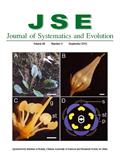Hong-Bo PANG, Qing-Wen SUN,Shun-Zhi HE,Yin-Zheng WANG﹡
Tengia has been called a “natural peloria” in the family Gesneriaceae because it exhibits an almost perfect actinomorphic flower from whorl one to whorl three. It would be especially interesting to know whether or how CYC-like gene activities are related to this type of perfect actinomorphic flowers. To address this, we have isolated four CYC-like TCP genes and conducted an investigation on their expression patterns in Tengia. TsCYC1C and TsCYC1D have similar expression patterns with strong signals being detected in all five petals and stamens, while TsCYC2A and TsCYC2B are only transiently expressed in the very early floral meristem. Our results suggest that the expansion of the expressions of TsCYC1C and TsCYC1D from the dorsal to the ventral petals is likely responsible for the evolutionary formation of the fully dorsalized actinomorphic corolla, i.e., an expanded functional domain of CYC-like gene dorsal identity in Tengia corolla. However, the expressions of TsCYC1C and TsCYC1D are not correlated with stamen abortion, that is, TsCYC genes do not functionally repress the stamen development in Tengia flowers, which is probably due to changed cis-activities that results in the cell cycle-related genes uncoupling from the TsCYC regulatory pathway in Tengia.

